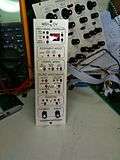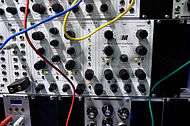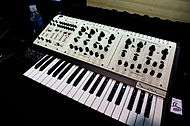Oberheim Electronics
Oberheim Electronics is a manufacturer of audio synthesizers and a variety of other electronic musical instruments. Founded in 1969[1][2] by Tom Oberheim (a former designer and contract manufacturer for Maestro).[3]
 | |
| Founded | 1969 |
|---|---|
| Founder | Tom Oberheim |
| Headquarters | Los Angeles, California |
Key people | Tom Oberheim, founder |
| Products | Signal processing, synthesizers, sequencers, drum machines |
History and products
.jpg)
Originally a manufacturer of electronic effects devices (most notably the Maestro phase shifter),[3] and briefly an ARP Instruments dealer,[3] Oberheim went on to create several ground-breaking products in the early days of synthesizers and electronic music including the DS-2 (one of the first digital music sequencers) and the Synthesizer Expansion Module (SEM).
Oberheim polyphonic synthesizers
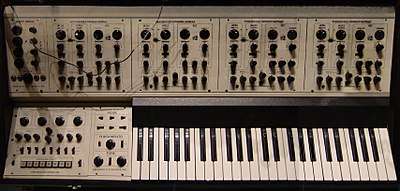
Oberheim's Two-voice TVS-1, Four-voice FVS-1 in 1975,[1] and Eight-voice in 1977,[4] (which was the four voice frame with an external 4 SEM module) were among the first commercially available polyphonic synthesizers. Configurations were based on the SEM. The Two-voice synthesizer included a two channel voltage controlled sequencer, and the Four-voice and Eight-voice machines included a rudimentary Programmer, capable of recalling sound settings.
Oberheim's later synths like the OB-X and OB-Xa abandoned the relatively bulky SEMs in favor of individual or compact voice cards, and common cabinetry and power supplies. Oberheim continued to make synthesizers until the late 1980s. Other notable Oberheim synthesizers include the OB-1 (monophonic), the OB-8, the Xpander, the Matrix-6, the Matrix-12, and the Matrix-1000 marketed after the acquisition by Gibson.[5][6]
Oberheim drum machines
Oberheim's DMX drum machine, a staple of early hip-hop music,[7] lent its name to the Producer Davy DMX, electro musician DMX Krew, and is still used in dancehall reggae music.
Both Marcus Ryle and Michel Doidic worked for Oberheim as instrument designers before helping develop the ADAT multitrack digital tape recorder for Alesis, (a 'prosumer' grade digital recording multitrack deck designed to compete with the Tascam DA series of digital multitracks) and then moving on to found Line 6 together.[8]
Oberheim/Gibson
Matrix-1000 (1988) Oberheim / Gibson Echoplex Digital Pro [9] |
 OB-Mx (1994) |
Oberheim went bankrupt and was acquired in 1985 by a group of lawyers who changed the name to Oberheim ECC. Tom was creatively still at the helm, although he left the company within a couple of years to start a new venture called Marion Systems. After a second bankruptcy in early 1988, Gibson Guitar Corporation, a larger musical instrument manufacturer (who, incidentally, also owned the Maestro brand), acquired Oberheim. Gibson, at the direction of Keith McMillen (Gibson's vice president and chief of R&D), then produced the Oberheim OB-Mx[10] in collaboration with D.N. "Lynx" Crowe and Don Buchla; the Oberheim Echoplex Digital Pro in collaboration with Aurisis Research (Matthias Grob, Kim Flint, Eric Obermühlner); and re-released the Oberheim Strummer and Matrix 1000.
Gibson had split from its parent company, Norlin, in 1986. Norlin handled distribution for Oberheim's major competitor, Moog Music.
Oberheim/Viscount

The trademark was later licensed to Viscount International, an Italian digital-organ producer. Viscount developed in a few years various instruments that were very innovative for the time and are still in demand: the digital synth Oberheim OB*12,[11] the guitar DSP GM-1000 with many effects,[12] the MC series of master keyboards,[13] and the OB32, a portable and inexpensive imitation of the popular Hammond series of organs.[14]
TomOberheim.com
In 2009, Tom Oberheim announced that he was manufacturing a new version of his classic analog SEM.[15][16][17][18]
In 2011–2012, Tom Oberheim announced a four-voice SEM called "Son Of 4 Voice" (SO4V),[19] as well as an updated version of the classic Two-Voice known as the Two-Voice Pro.[20] The "Son Of 4 Voice", also known as SO4V, the Two Voice Pro started shipping in 2014.[21]
At the NAMM show of January 2016, Tom Oberheim announced the Dave Smith Instruments OB6, a collaboration with Dave Smith which resulted in Tom Oberheim's first voltage-controlled multi-voiced polyphonic synth since the mid-1980s; Tom Oberheim designed the VCO/VCF part replicating his SEM module, while control features, arpeggiator/step sequencer and effects processing were designed by Smith using his Prophet platform.[22]
Oberheim Electronics returns
In July 2019, JC Curleigh, CEO of Gibson, returned the Oberheim Electronics brand and IP back to Tom Oberheim as "a gesture of goodwill to the musical instrument industry."[23]
See also
- Tom Oberheim
- E-mu Systems
- Gibson Guitar Corporation
- Viscount
References
- "Session Transcript: Tom Oberheim". Red Bull Music Academy, Barcelona 2008. Archived from the original on 2018-05-07. Retrieved 2016-11-27.
-
Susan Caust Farrell (1981). Directory of contemporary American musical instrument makers. University of Missouri Press. pp. 101. ISBN 978-0-8262-0322-9.
Oberheim Electronics 1973 -wikipedia -wapedia.
- Trevor Pinch & Frank Trocco (2002). Analog Days. Harvard University Press. p. 270. ISBN 0-674-01617-3.
- "Oberheim Eight Voice". Vintage Synth Explorer.
- "Oberheim Matrix 1000". Sound on Sound (June 1994).
- "Access Oberheim Matrix 1000 Programmer". Sound on Sound (September 1996).
- "Oberheim DMX". Vintage Synth Explorer.
- Mark Vail (1993). Vintage Synthesizers. Miller Freeman Books. p. 21. ISBN 0-87930-603-3.
- Matthias Grob. "How the Gibson / Oberheim Echoplex Came Together". Loopers-Delight.com.
- "Oberheim OBMx". Sound on Sound (September 1994).
- "The Synth Sequel - Oberheim/Viscount OB12 Analogue Modelling Synth". Sound on Sound (September 2000).
- Oberheim GM-1000 - 24bit Digital Signal Processor - Operating Manual (PDF). Oberheim (Viscount joint venture).
- "Stereo MCS - Oberheim/Viscount MC3000 & MC2000 Controller Keyboard". Sound on Sound (November 1999).
- "Oberheim/Viscount OB3-squared". Sound on Sound (September 1997).
- "Tom Oberheim Introduces New Oberheim SEM Synthesizer". Synthtopia.com. June 4, 2009.
- "Tom Oberheim". TomOberheim.com. 2009. Archived from the original on 2009-08-09. — Tom Oberheim reissued SEM in 2009.
- "Tom Oberheim Synthesizer Expander Module with MIDI to CV Panel". audioMIDI.com. Archived from the original on 2009-08-15.
- "Tom Oberheim SEMs Shipping - First Impression". MATRIXSYNTH. September 30, 2009.
- "Son Of 4 Voice Polyphonic Synthesizer: "SO4V"". TomOberheim.com. 2011. Archived from the original on 2011-02-07. — Tom Oberheim announces Oberheim 4 Voice in 2011.
- "New! Two Voice Pro Synthesizer". TomOberheim.com. 2012. Archived from the original on 2012-03-24. — Tom Oberheim announces Oberheim Two Voice Pro in 2012.
- "Tom Oberheim". TomOberheim.com. 2013.
- "Dave Smith and Tom Oberheim OB-6 - A Historic Collaboration". YouTube, DaveSmith Instruments. 21 January 2016. Retrieved 2016-01-24.
- "Gibson Returns Oberheim Trademark to Namesake Founder As "Gesture of Goodwill"". Guitar.com. Retrieved 28 August 2019.
External links
| Wikimedia Commons has media related to Oberheim Electronics. |
- Oberheim Abbey Synthesizer Discussion Forum
- Oberheim Zone at SynthZone.com
- Oberheim overview at SynthSale
- Viscount Italy main site
- TomOberheim.com The new Oberheim site
- Tom Oberheim NAMM Oral History Interview (2005)
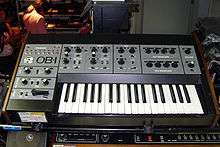
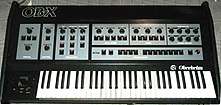

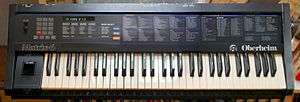
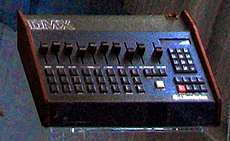
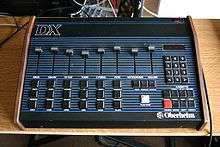
.jpg)
